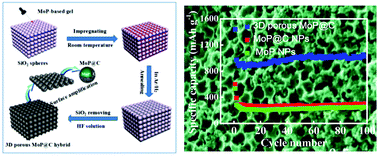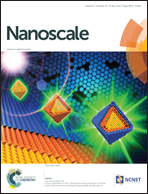A three-dimensional porous MoP@C hybrid as a high-capacity, long-cycle life anode material for lithium-ion batteries†
Abstract
Metal phosphides are great promising anode materials for lithium-ion batteries with a high gravimetric capacity. However, significant challenges such as low capacity, fast capacity fading and poor cycle stability must be addressed for their practical applications. Herein, we demonstrate a versatile strategy for the synthesis of a novel three-dimensional porous molybdenum phosphide@carbon hybrid (3D porous MoP@C hybrid) by a template sol–gel method followed by an annealing treatment. The resultant hybrid exhibits a 3D interconnected ordered porous structure with a relatively high surface area. Benefiting from its advantages of microstructure and composition, the 3D porous MoP@C hybrid displays excellent lithium storage performance as an anode material for lithium-ion batteries in terms of specific capacity, cycling stability and long-cycle life. It presents stable cycling performance with a high reversible capacity up to 1028 mA h g−1 at a current density of 100 mA g−1 after 100 cycles. By ex situ XRD, HRTEM, SAED and XPS analyses, the 3D porous MoP@C hybrid was found to follow the Li-intercalation reaction mechanism (MoP + xLi+ + e− ↔ LixMoP), which was further confirmed by ab initio calculations based on density functional theory.


 Please wait while we load your content...
Please wait while we load your content...